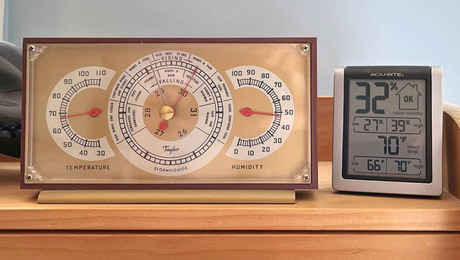Here’s a real headache for guys that rough in a lot of stairs. Some well meaning soul sends you some nice straight 16′ 2x12s for your rough in, now you start laying out your rise and runs. What happens when you can’t discern a crown? Does that mean that there isn’t one there? Hold the phone please!!! There is sometimes one there that gets released when you cut out your steps, only problem is it could go the wrong way resulting in a call back making you look like the original dufus. How do you address the problem before its too late?
Larry are you there when I really need you?


















Replies
use micro lam instead.
# # # # # # # , # # #--# # # # !
Don't mention the L word (I got a legal notice from him the other day!)
The engineered lumber is a great idea, too bad no contractor will go for it...the next rough set I cut will be with the crown down, I'm only asking for some compensation;-) It's okay, I can fix it!
"I got a legal notice from him the other day!"
I'm not so good at keeping up with old friends, I guess I lost touch with the old boy.Excellence is its own reward!
nail top then bottom ( using a joist hanger set in a saw kerf ) string a line and then nail off with appropriate spacer between stringer and support wall.
I thought y'all were building an open stair.# # # # # # # , # # #--# # # # !
Benny, I'm talking about cutting out a stringer......just laying on your sawhorses. A straight board will some times have a mind of it's own. How do you tell wich way it will go?
Sometimes it's like forcasting a woman's actionsExcellence is its own reward!
if a board still has internal stress, its not totally dry or ready to be used. Chances are it wasnt dried correctly. YOu can post over on knots about this if you want more detailed responses about wood movement. But i know if you cut 6 inches in a board, remove the center section, leaving a u shape, and if the ends curl the board wasnt dried right or still has too much moisture. (i foget the term to describe this procedure)
I think you're going to find that it's not really possible to determine assuredly which way a board is going to move because of its internal stresses.
A better plan is to choose the stock for your stringer with care. Try to find a piece of stock that has grain that runs straight down the length of the board and has nice tight grain. Avoid pieces with wild looking curvy grain that appear to have been cut near a crotch or from stress wood.
If you’re forced to use a piece that doesn’t look like prime stock for a stringer, I’m thinking that if your particular project would allow you could sister a nice 2x4 with construction adhesive and screws, on the inside of what will be the untouched portion of the stringer prior to doing any cutting. This additional piece would likely be capable of restraining the stringer from moving once the tread cutouts are made.Knowledge is power, but only if applied in a timely fashion.
You're exactly right. The best kiln-drying in the world can't remove the stress in a piece of wood that grew to overcome a dramatic force, like heavy wind, or gravity or the sliding or the settling of the ground it grew on or whatever.
Production dry kilns operate on drying schedules established for the most common to type of the species and grade being dried. Case hardening can be reduced by "conditioning" at the end of a schedule, but it's rarely done anymore and is not a cure-all. Murphies Law will offer up a bad piece for a critical place unless you're observant.
In this day and age, I've kind of swung over to the use of engineered lumber for things like stair jacks. I even used some 14" Versa-Rim recently on a set of stairs, doubling up the center jack and I liked the result. In terms of cost, I think it probably was a little cheaper, all things considered; especially since it was leftovers.
case hardening, thats the term i was trying to dig out of the old noggin. Most dimension lumber is kiln dried to around 19% and thats giving the boards wide lattitude. Most furniture grade lumber is prefered to be WAY lower. Dimension lumber isnt the most precise milling around. No real consideration is given to grain orientation when cuts are made.
Oh jeez.......why did I say "stringer", the guy's talking about a stair horse an so was I. Duh.Knowledge is power, but only if applied in a timely fashion.
I always cut the side of the board that has the wider grain .
This leaves more strenghth in the wood thats left. it also has a tendency to put a crown in the stringer in the direction you want it to go (crown always goes up) The bigger the difference in the size of the grain usually means the more it will move on you. Of course moisture content will affect this as well. The drier the wood the more the grain will affect it.
Benny, That's an interesting idea, I have looked at the grain pattern trying to get a clue but I never thought about the difference in width.
The only way I've been able to tell for sure is to make a cut above or below my layout lines and see if my kerf pinches, if it does I know the board is moving the wrong way and I need to flip it over a re-lay it out. But if you don't have enough waste left past your layout lines then this won't work. I finally just informed the stair co. I sub to that if they deliver me a straight board and it goes the wrong way its their baby.
We have another interesting situation. Our stairway is 54" wide so you can take oversized furnitureee up & down it w/o a pain, and eventually install a side-saddle electric chair to get us up & down in our dottage. Has two stringers, and two center supports - I guess that's what you all called a horse? It's been in for two yrs now, w/ only temp treads on it because we are so slow at completing this work of art. We had a real carpenter do this - I am not capable of doing stairs, and know it.
The volume under our stairs is our tornado shelter, flanked by reinforced concrete walls rated at 250 mph winds. Door is a prison door, rated at same. Looked up t'other day & decided that if the roof fell in, the stair stringers, et al, would crack at the step notches. Took stairway apart and installed two 6" deep channels, sistered to the Horses (?) w/ 5 half inch bolts each, and held in place laterally by two smaller channels at the third points. Figured via some in-the-head engineering that this should at least slow up the jackstraw pile of roof and second floor parts should they make it down the stairway. Two center stringers (horses?) already had 2X6's sistered to them for added stiffness.
Kinda an interesting effect when finished and reassembled. Stairs seem much stiffer now. My wife had a miserable time negotiating the stairway before modification, having to hold on to the wall when going down. She didn't feel very secure. Now, after the second trip down, she does it w/o holding on, just like everyone else, carrying two armloads of junk. I was very surprised at this very subtle change in character of the structure. I would have thought it my imagination, were it not for wife's dramatic change in how she negotiated stairs, and she changed w/o thinking about it, and agrees w/ me that stairs seem stiffer now.
Now for a question: When removing temp treads, I noticed that the nails didn't hold very well because they were at roughly 45 degrees to grain. Since I cost my time at about ten cents an hour, I'd like to place some nice, hard yellow pine 2X4's along side the tread surfaces to increase the holding power of the nails/screws (Whatever) that my finish carp uses to install stair treads. Any reason why I should not??? I can get the yellow pine at my local HD free as pallet skids they will toss. Some of that stuff is hard as bricks.
DonThe GlassMasterworks - If it scratches, I etch it!